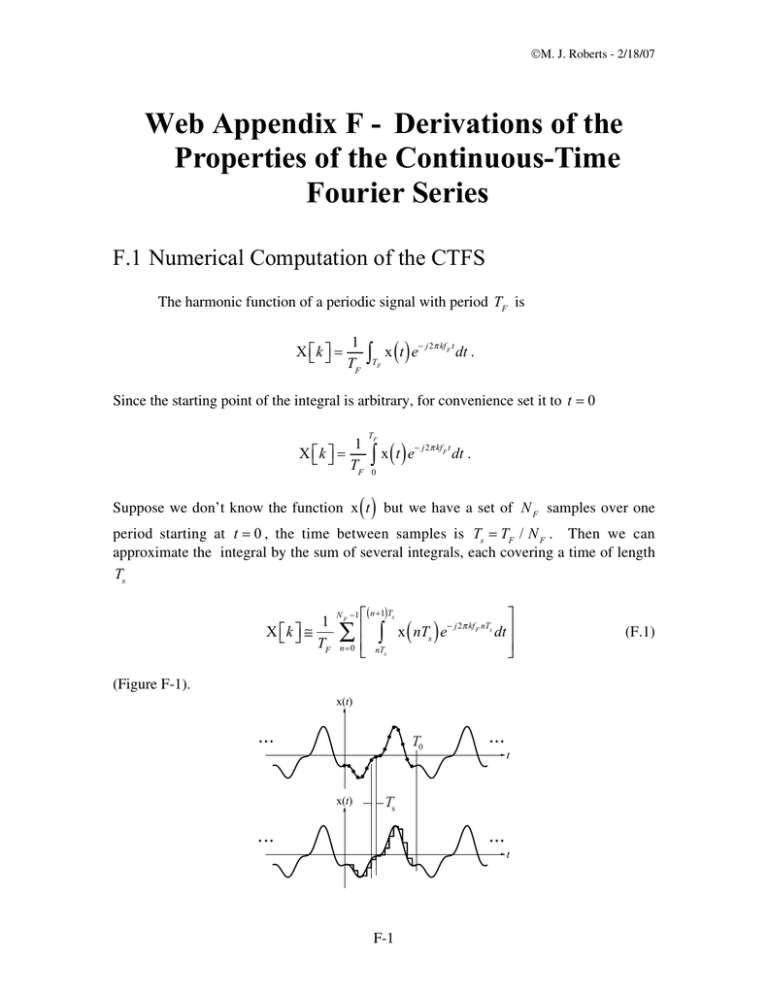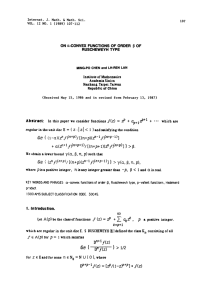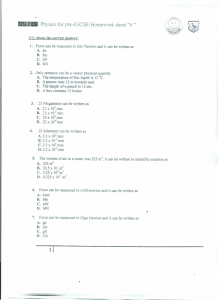Web Appendix F - Derivations of the Fourier Series ( )
advertisement

M. J. Roberts - 2/18/07 Web Appendix F - Derivations of the Properties of the Continuous-Time Fourier Series F.1 Numerical Computation of the CTFS The harmonic function of a periodic signal with period TF is X k = x (t ) e 1 TF j 2 kf F t TF dt . Since the starting point of the integral is arbitrary, for convenience set it to t = 0 1 X k = TF TF x (t ) e j 2 kf F t dt . 0 () Suppose we don’t know the function x t but we have a set of N F samples over one period starting at t = 0 , the time between samples is Ts = TF / N F . Then we can approximate the integral by the sum of several integrals, each covering a time of length Ts 1 X k TF N F 1 n=0 ( n+1)Ts x nTs e j 2 kf F nTs dt nTs ( ) (Figure F-1). x(t) ... T0 x(t) ... t Ts ... ... t F-1 (F.1) M. J. Roberts - 2/18/07 Figure F-1 Sampling the arbitrary periodic signal to estimate its CTFS harmonic function (In Figure F-1, the samples extend over one fundamental period but they could extend over any period and the analysis would still be correct.) If the samples are close enough () together x t does not change much between samples and the integral (F.1) becomes a good approximation. We can now complete the integration. 1 X k TF 1 X k TF N F 1 N F 1 ( n+1)Ts 1 x nTs e j 2 kf F t dt = TF nTs ( ) n=0 N F 1 ( ) n=0 e j 2 kf F nTs e j 2 kf F ( n+1)Ts 1 e j 2 kf F Ts x nTs = j2 kf F j2 kf F TF ( ) n=0 Using Ts = TF / N F , j 2 k / N F N F 1 1 e X k j2 k x ( nT ) e j 2 nk / N F =e s j k / N F n=0 X k e e j k / N F j k / N F ( ( n+1)Ts e j 2 kf F t x nTs j2 kf F nT s N F 1 x ( nT ) e j 2 kf F nTs s n=0 j 2 sin ( k / N F ) j k / N F j k / N F N F 1 e e j 2 nk / N F x nTs e j2 k n=0 ( ) ) N 1 1 sin k / N F F x nTs e j 2 nk / N F NF k / NF n=0 sinc ( k / N F ) ( sinc k / N F ) ( ) N F 1 x ( nT ) e j 2 nk / N F s NF n=0 For harmonic numbers k << N F we can further approximate the harmonic function as 1 X k NF N F 1 x ( nT ) e j 2 nk / N F s . n=0 F.2 Linearity () () () Let z t = x t + y t . If TF = mT0 x = qT0 y , where m and q are integers, then () the CTFS harmonic function of z t is Z k = 1 TF z (t ) e TF j 2 kf F t dt = 1 TF F-2 TF () () x t + y t e j 2 kf F t dt M. J. Roberts - 2/18/07 and () z t = n= Z k e j 2 kf F t ( X k + Y k ) e = j 2 kf F t n= and Z k = X k + Y k . So the linearity property is TF = mT0 x = qT0 y () () FS x t + y t X k + Y k . F.3 Time Shifting () ( ) Let z t = x t t0 and let TF = mT0 x = mT0 z , where m is an integer. Then Z k = 1 TF z (t ) e jk F t TF dt = 1 TF x (t t ) e jk F t 0 TF dt . Making the change of variable = t t0 d = dt , Z k = 1 TF x ( ) e ( jk F +t0 ) TF d = e jk F t0 () 1 jk x e F d T TF F = X k Z k = e jk F t0 X k . So the time-shifting property is TF = mT0 ( ) x ( t t ) e FS x t t0 e j 2 kf F t0 FS 0 F-3 jk F t0 X k . X k M. J. Roberts - 2/18/07 F.4 Frequency Shifting () Let z t = e j 2 k0 f F t () x t , with k0 being an integer and TF = mT0 x = mT0 z , where m is an integer. Then Z k = 1 TF z (t ) e j 2 kf F t TF Z k = 1 TF dt = x (t ) e 1 TF ( e TF ) j 2 k k0 f F t TF j 2 k0 f F t () x t e j 2 kf F t dt dt = X k k0 . So the frequency shifting property is TF = mT0 e () x ( t ) X k k j 2 k0 f F t e jk0 F t FS x t X k k0 . FS 0 F.5 Time Reversal () ( ) Let z t = x t and let TF = mT0 x = mT0 z , where m is an integer. If ( ) X k e x t = j 2 kf F t k = then ( ) x t = k = X k e ( ) j 2 kf F t = X k e ( ) j 2 kf F t . k = Let q = k , then ( ) X q e x t = j 2 qf F t q= and, since changing the order of summation does not change the sum, ( ) X q e x t = j 2 qf F t q = Therefore, since ( ) Z k e z t = k = we can say that F-4 j 2 kf F t . M. J. Roberts - 2/18/07 k = Z k e j 2 kf F t = X k e j 2 kf F t k = and Z k = X k . So the time reversal property is ( ) TF = mT0 . FS x t X k F.6 Time Scaling () ( ) Let z t = x at , a > 0 and let TF = mT0 x , m an integer. (Figure F-2). x(t) t T0x z(t) t T0x a () () Figure F-2 A signal x t and a time-scaled version z t of that signal () The first thing to realize is that if x t is periodic with fundamental period T0 x that () z t is periodic with fundamental period T0 z = T0 x / a and fundamental frequency af0 x . () () Case 1. z t represented by a CTFS over a period of z t , TF / a . The CTFS harmonic function will be a Z k = TF t0 +TF / a t0 () z t e j 2 kaf F t a dt = TF t0 +TF / a ( ) x at e t0 We can make the change of variable = at d = adt yielding F-5 j 2 kaf F t dt . M. J. Roberts - 2/18/07 a 1 Z k = TF a at0 +TF x ( ) e j 2 kaf F / a at0 1 d = TF at0 +TF x ( ) e j 2 kf F d . at0 Since the starting point t0 is arbitrary Z k = 1 TF x ( ) e j 2 kf F TF d = X k () and the CTFS harmonic function describing z t over the period TF / a is the same as () the CTFS harmonic function describing x t over the period TF . () ( ) z t = x at TF = mT0 x TF / a = mT0 x /a Z k = X k () () Even though the CTFS harmonic functions of x t and z t are the same, the CTFS representations themselves are not because the fundamental frequencies are different. The representations are () x t = k = X k e j 2 kf F t () ( ) Z k e z t = x at = and j 2 kaf F t . k = () () Case 2. z t represented by a CTFS over a period of x t , TF The CTFS harmonic function will be 1 Z k = TF t0 +TF z (t ) e j 2 kf F t t0 1 dt = TF t0 +TF x ( at ) e j 2 kf F t dt . t0 Let = at d = adt . Then 1 Z k = aTF at0 + aTF () x e j 2 kf F / a d . at0 If a is not an integer, the relationship between the two harmonic functions Z k and X k cannot be simplified further. F-6 M. J. Roberts - 2/18/07 () Let a be a non-zero integer. The signal x t is made up of frequency components at integer multiples of f F . () Therefore for ratios k / a that are not integers, x and j 2 kf F / a are orthogonal on the interval at0 < < at0 + aTF and Z k = 0 . For ratios k / a that are integers, the integral over a periods is a times the integral over one period and e 1 Z k = a aTF at0 +TF () x e ( ) j 2 k / a f F at0 d = X k / a , k / a an integer . So the time scaling property, for this kind of time scaling, is () ( ) TF = mT0 x , z t = x at , a a non-zero integer X k / a , k / a an integer Z k = , otherwise 0 . F.7 Change of Period () () If the CTFS harmonic function of x t over any period TF is X k , we can find the CTFS harmonic function X q k of x t over a time qTF where q is a positive integer. The new fundamental CTFS frequency is then f F / q and X q k = 1 qTF qTF () x t e ( ) j 2 kf F / q t dt This is exactly the same as the result for time scaling by a positive integer in the previous section and the result is X k / q , k / q an integer TF qTF X q k = . , otherwise 0 F.8 Time Differentiation ( ) dtd ( x (t )) and let T can represent z ( t ) by Let z t = F = mT0 x = mT0 z , where m is an integer. Then we F-7 M. J. Roberts - 2/18/07 () z t = d d jk t jk t x t = X k e F = jk F X k e F . dt dt n= n= ( ( )) Then, if ( ) Z k e z t = jk F t k = it follows that k = Z k e jk F t = jk F X k e jk F t , k = Z k = jk F X k . So the differentiation property is TF = mT0 ( ( )) ( ( )) . d d FS FS x t j2 kf F X k , x t jk F X k dt dt F.9 Time Integration ( ) x ( ) d Let z t = t and let TF = mT0 x , where m is an integer. We must consider two cases separately, X 0 = 0 and X 0 0 . If X 0 0 then, even though x t is periodic, z t is not and we cannot represent it exactly for all time with a CTFS () () (Figure F-3). F-8 M. J. Roberts - 2/18/07 X[0] = 0 X[0] = 0 x(t) x(t) ... ... ... ... t t t tt ∫x(λ)dλ x(τ)dτ ∫−∞ ∫ x(τ)dτ −∞ ... ... t t Figure F-3 Effect of a non-zero average value on the integral of a periodic function () If X 0 = 0 then we can represent z t by t ( ) x ( ) d z t = and its CTFS harmonic function is Z k = 1 TF x ( ) d e t TF jk F t dt . For k = 0 , Z 0 = 1 TF x ( ) d dt t TF () which is the average value of the integral of x t over one fundamental period. We () know that the average value of x t is zero but, without some other information, we () don’t know what the average value of the integral of x t is and cannot determine the value of Z 0 . However we can determine all the other values of Z k . t t ( ) x ( ) d = X k e d = X k e = k k = z t = jk F t jk F d () x 1 Z k = T F jk F t t jq F e X q d dt e TF q = F-9 (F.2) M. J. Roberts - 2/18/07 In (F.2) k has been replaced by q to avoid confusion with k which is independent of q. To finish the integration we must evaluate the integral t e jq F d which is t e jq F . jq F Evaluation at the upper limit is not a problem but the lower limit does present a problem. jq Since the complex sinusoid e F is periodic it is impossible to define what its value is at the lower limit of negative infinity because negative infinity is a limit, not a number. The jq magnitude of e F is one but its phase could be any value in a range of 2 radians. But, it turns out that this won’t matter. Call the indeterminate value at the lower limit C. Then t jq t e jq F e F C = jq F jq F and jk t e jq F t X q C e F dt TF q = jq F j q k t X q e ( ) F jk t = Ce F dt TF q = TF jq F 1 Z k = TF For each k 0 the computation involves a summation of terms involving q. But all of those terms are zero unless q = k because the integration is over a integer number of periods of a complex sinusoid. So, in the end, Z k = X k TF X k X k 1 dt = T = , k0 TF jk jk F TF F jk F F and the integration property is TF = mT0 t () x d FS X k j2 kf F t , () FS x d F-10 X k jk F , k 0 , if X 0 = 0 . M. J. Roberts - 2/18/07 F.10 Multiplication-Convolution Duality () () () Let z t = x t y t and let TF = mT0 x = qT0 y , where m and q are integers. Then Z k = 1 TF z (t ) e j 2 kf F t TF dt = x (t ) y (t ) e 1 TF j 2 kf F t TF dt . Then, using () y t = k = Y k e j 2 kf F t = Y q e j 2 qf F t q = we get Z k = 1 TF j 2 kf t j 2 qf F t F x t Y q e dt . e TF q = () Reversing the order of integration and summation, Z k = Y q x (t ) e 1 TF j 2 qf F t j 2 kf F t e TF q = dt or Y q T x (t ) e Z k = 1 ( ) j 2 k q f F t dt . q = F TF = X k q Then Z k = Y q X k q q = and the multiplication property is TF = mT0 x = qT0 y () () x t y t FS Y q X k q = X k Y k . q = This result q = Y q X k q is a convolution sum. So the product of CT signals corresponds to the convolution sum of their CTFS harmonic functions. Now let Z k = X k Y k and let TF = mT0 x = qT0 y , where m and q are integers. Then F-11 M. J. Roberts - 2/18/07 ( ) X k Y k e z t = jk F t k = () z t = 1 T k = F () TF x e jk F d Y k e jk F t = 1 TF ( ) Y k e TF x d ( jk F t ) k = ( y t ) or () z t = x ( ) y (t ) d 1 TF TF . This integral looks just like a convolution integral except that it covers the range t0 < t0 + TF instead of < < . This integral operation is called periodic convolution and is indicated by the notation () ( ) x ( ) y (t ) d x t y t = Therefore TF () ( ) () . () z t = 1 / TF x t y t . () Since x t is periodic it can be expressed as the periodic extension of an () aperiodic function x ap t ( ) x (t qT ) = x (t ) (t ) . x t = ap q = F ap TF () (The function, x ap t , is not unique. It can be any function which satisfies this equation.) Then x t y t = x ap qTF y t d TF q = () () () t0 +TF q = t0 () x t y t = ( ) ( ( ) ( ) ) x ap qTF y t d . Let = qTF . Then d = d and () ( t0 + q +1 TF q = t0 + qTF () x t y t = ) ( ) ( ( )) x ap y t + qTF d . () Since y t is periodic, with period TF , F-12 M. J. Roberts - 2/18/07 ( ( )) = y (t qT y t + qTF and the summation of integrals infinite limits F ( ) t0 + q +1 TF q = t + qT 0 F ) ( = y t ) is equivalent to the single integral over we conclude that () ( ) x ( ) y (t ) d = x (t ) y (t ) . x t y t = ap ap () () expressed as an aperiodic convolution of y ( t ) with a function x ( t ) which, when periodically repeated with the same period T equals x ( t ) . The periodic convolution of So the periodic convolution of two functions x t and y t each with period TF can be ap F two periodic functions corresponds to the product of their CTFS harmonic function representations and the period TF and the convolution property is TF = mT0 x = qT0 y () () FS x t y t TF X k Y k . F.11 Conjugation () () Let z t = x * t and let TF = mT0 x = mT0 z , where m is an integer. Then Z k e j 2 kf F t k = = = X k e j 2 kf F t k = X * k = k e j 2 kf F t * = X k = * k e j 2 kf F t and, since changing the order of summation does not change the sum, k = Z k e j 2 kf F t = X k = * k e j 2 kf F t , Z k = X * k and the conjugation property is () TF = mT0 FS x * t X * k F-13 . M. J. Roberts - 2/18/07 F.12 Parseval's Theorem The signal energy in any period TF = mT0 x , where m is an integer, of any () periodic signal x t is Ex,T = F Ex,T F F Ex,T F Ex,T F x t TF = TF Ex,T = () 2 X k e dt = TF 2 j 2 kf F t dt k = * X k e j 2 kf F t k = j 2 qf F t dt X q e q = X k e j 2 kfF t X* q e j 2 qfF t dt TF k = q = j 2 k q f t = X k X * q e ( ) F dt TF k = q = j 2 ( k q ) f F t * * dt = X k X k + X k X q e TF k = k = q = k q Ex,T = F TF k = 2 X k dt + TF X k X k = q = k q * q e ( ) j 2 k q f F t dt =0 , k q Ex,T = TF F X k k = 2 () Therefore, for any periodic signal x t TF = mT0 1 TF () TF x t 2 dt = k = F-14 X k 2 .



